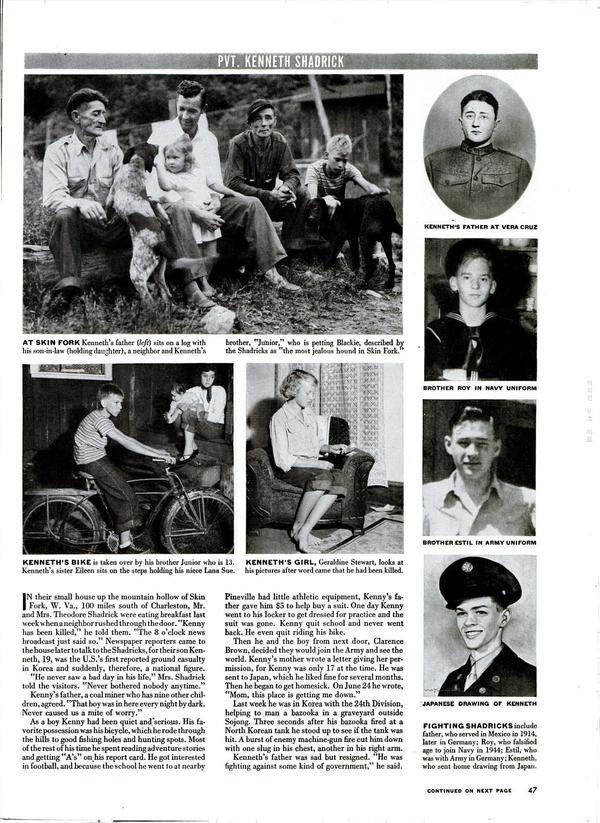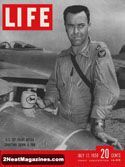

About 90 minutes after Task Force Smith began its withdrawal from the Battle of Osan, the 34th Infantry sent Shadrick as part of a small scouting force northward to the village of Sojong-ni, 5 miles (8.0 km) south of Osan.
죽미령에서 인민군 탱크부대와 조우한 스미스 부대는 7월 5일 오전 8시 16분에 첫 발포를 하였으나 인민군의 탱크는 전혀 손상이 없었다. 할 수 없이 약 90분후에 오산 전투지역으로부터 후퇴를 시작했고, 서정리 북쪽 방향, 오산에서 남쪽으로 약 8km 되는 지점에 34연대 소속의 바주카 분대원 새드릭 일병을 소규모 정찰대 병력의 일원으로 보냈다.
His death is now believed to have occurred after the first American combat fatalities in the Battle of Osan. Since the identities of other soldiers killed before Shadrick remain unknown, he is still often incorrectly cited as the first U.S. soldier killed in the war. 현재까지도 새드릭 일병의 사망은 오산전투애서 전사한 최초의 미군으로 불확실하게 알려져 왔는데 새드릭 일병 이전에 사망한 병사가 있었는지 불명하기 때문이다.

Theodore Shadrick, a gaunt, silent man with a face seamed by 37 years in the coal mines, was eating breakfast with his wife when he heard the sound of running feet. A neighbor burst through the doorway of the Shadricks' mountain shack with a breathless shout.
"Kenny's been killed! The 8 o'clock broadcast just said so."
Lucille Shadrick, a thin and bony woman, left the table, sobbing. Theodore Shadrick stared stonily, pondering the news that the fourth oldest of his six sons and four daughters was gone. "He was the best there was," said Theodore finally. "Never caused us a mite of worry."
Soon everybody in the mountain miners' hamlet of Skin Fork, W.Va. — about 150 people — had heard the news that put their home town on the U.S. front pages: Private Kenneth Shadrick, 19, of Skin Fork, was the first U.S. foot soldier reported killed in the battle for Korea.
Half a World Away. Waiting for the telegram from the Government in Washington (which arrived two days later), the Shadricks assembled their recollections of Kenny. It was probably the football uniform, his father decided, that started Kenny on the way to his death, half a world from Skin Fork.
Until the family moved to Skin Fork four years ago and Kenny entered Pineville High School, seven miles away, Kenny's main interests were riding his bike, hunting a little now & then, and reading—mainly westerns and a magazine called Fantastic Novels. "All that boy liked was to sit hunched up there with a book and a piece of cold bread," said his father.
At Pineville, Kenny fell in love with football. His father scraped together $5 to help buy his football uniform, Pineville High being a poor school with little money to spend on athletics. For a month Kenny practiced hard, trying to make the team; he was wiry and quick but light (130 lbs., 5 ft. 10 in.). One October day when he showed up for practice, Kenny opened his locker and found that his football suit was gone—stolen. He gathered up his books, went home and told his mother: "I'll never go another day of school."
Seeing the World. A month later, Kenny had passed his physical, had a letter of permission from his folks (he was only 17) and joined the U.S. Army.
At first, he got a thrill out of Japan.
By last month, he had seen enough. "Mom," he wrote home, "this place is getting me down."
Last week, Private Kenny Shadrick and his buddies were a bazooka squad in a graveyard near the town of Sojong, close to the advancing North Korean Reds. Kenny aimed a bazooka rocket at an enemy tank, counted three while the rocket lobbed toward the target, then stuck his head & shoulders above the gun pit to watch. The tank's machine gun chattered and Kenny Shadrick tumbled backward, a bullet through his right arm, another through his chest.
The neighbors dropped in on the Shadricks to speak their sympathy and leave quietly. It was the newspapermen from out of town who asked the fancy questions. What was Kenny fighting for? "Against some kind of government," said Theodore Shadrick simply. Where was Korea? He didn't know—out there somewhere, where his boy had been killed.
End
Full page American Iron and Steel Institute ad featuring high school graduate John Stroud. Cute photo of wren (bird) building nest in a galosh hung up on a clothesline. War by jet and GI. Strange case of the circus arsonist, Robert Dale Segee. Two boats fight Colorado river rapids, Ed Hudson through Grand Canyon in a motor boat. 11-year-old girl is made a saint, Maria Goretti. The week the war ended (WWII) , by Robert L. Schwartz. Photo essay - world of William Wordsworth. Nerve gas. Faith

Domergue. Life visits Sheriff “Buckshot” T.W. Lane. Pretty full page Chesterfield cigarettes ad with Marta Joren. The home front becomes aware of Korea, includes photos of William Goodwin, Remer Laverne Harding, Kenneth Shadrick, Earl Francis Godfrey and others. Painters H.O. Kelly and Augusta Isabel Corson Metcalfe. Full page color Pabst Blue Ribbon beer ad with tennis player Pancho Gonzales. Giant bubble maker, Christopher Martin. Cute full page color Howard Johnson's restaurants ad. Article on actress Faith Domergue. Former "Yank" correspondent Robert L. Schwartz tells of a week with the top-secret B-29 squadron that dropped the Atomic bomb.

'스토리 > 역사속으로' 카테고리의 다른 글
| 1950년 7월5일 179명 전사 (1) | 2023.05.28 |
|---|---|
| 이 한 장의 사진2*1950년7월5일 (0) | 2023.05.28 |
| 문화재 된 ‘간호교과서’… 한글 연구에 도움 (0) | 2023.05.28 |
| [역사 속 오늘]수많은 제주도민들 희생된 '4·3사건' (0) | 2023.05.28 |
| [대한민국 제1호 大使 張勉] (2) | 2023.05.28 |